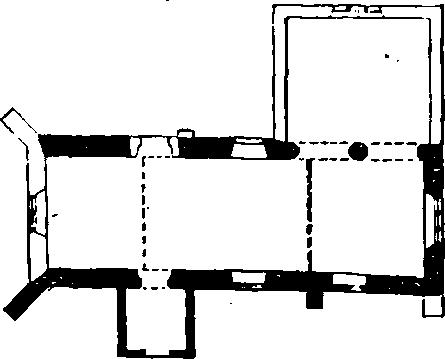Pages 80-81
An Inventory of the Historical Monuments in Essex, Volume 4, South east. Originally published by His Majesty's Stationery Office, London, 1923.
This free content was digitised by double rekeying and sponsored by English Heritage. All rights reserved.
In this section
46. LAINDON HILLS. (C.d.)
(O.S. 6 in. (a)lxxvi. N.W. (b)lxxvi. N.E.)
Laindon Hills is a parish on the high ground 7 m. N.N.E. of Tilbury. The church is the principal monument.
Ecclesiastical
a(1). Parish Church of All Saints (Plate, p. xxxiii) stands towards the S.W. corner of the parish. The walls are partly of ragstone and flint-rubble and partly of red brick; the dressings are of limestone; the roofs are tiled. The Nave and Chancel were built in brick early in the 16th century, but the flint-rubble in the lower part of the walls and the jamb-stones of the S. doorway indicate the existence of an earlier building. Early in the 17th century a N. chapel was added and later in the same century the South Porch was built. The North Chapel was re-built about 1834 and the W. wall and bell-turret are also modern.
Among the fittings the Royal Arms painted on plaster are noteworthy.

The Church, Plan
Architectural Description—The Chancel (15 ft. square) has an early 16th-century E. window of brick and of three four-centred lights with vertical tracery in a two-centred head with a moulded label. In the N. wall is an early 17th-century arcade of two bays with round arches of two chamfered orders and an octagonal column and semi-octagonal responds with moulded capitals; the whole is in plastered brick; on the S. face, between the arches are the initials and date R.E. 1621, in plaster. In the S. wall is an early 16th-century window of brick and of two four-centred lights in a four-centred head. The chancel is structurally undivided from the nave.
The Nave (32¾ ft. by 14½ ft.) has in the N. wall an early 16th-century window with a four-centred head, now blocked; further W. is the modern N. doorway. In the S. wall is a window similar to the S. window of the chancel; further W. is the S. doorway with mediaeval chamfered lower jambs of stone and early 16th-century segmental arch and upper jambs of brick, with a square moulded label. In the W. wall is a modern window.
The South Porch is of 17th-century brick and has an outer archway with a plain wooden lintel.
The Roof of the chancel is plastered, but has a central purlin and a tie-beam at the W. end with mortices for a former screen in the soffit and plastered framing above it. The early 16th-century roof of the nave is also plastered, but has one king-post truss and above the wall-plate on the N. side is the inscription in plaster "Thomas Richardson John Elliett Nov 1666"; the W. bay of the roof is modern. The S. porch has a 17th-century collar-beam roof.
Fittings—Bells: two, 1st uninscribed; 2nd by Thomas Lawrence, early 16th-century. Brass Indent: In nave—of heads of man and woman (?), and marginal inscriptions, early 14th-century. Communion Table: In chancel—with turned legs and shaped brackets under top rails, late 17th-century. Communion Rails: with turned balusters and square posts, moulded rail with initials and date S.S.R. 1686 W.E.C. Font: In stables at rectory—octagonal bowl with moulded upper and lower edge, trefoil-headed panels in each face and on stem, moulded base, 15th-century. Monument and Floor-slabs. Monument: In churchyard—S. side, to Robert Benton, 1712, head-stone. Floor-slabs: In chancel—(1) to Thomas Richardson, 1669; (2) to Ann, wife of Thomas Richardson, 1630, also to Elizabeth, wife of Thomas Richardson, son of the above, 1666, and George and Elizabeth, two of her children. Panelling: In nave—incorporated in pew, 17th-century. Royal Arms (Plate, p. 79): on plastered framing between nave and chancel, painted arms dated 1660, and below it black-letter inscription from Proverbs 24, 21 and the name John Elliett, Churchwarden.
Condition—Disused and rapidly becoming ruinous.
Secular
a(2). Little Malgraves, house and barn, ½ m. W.S.W. of the church. The House is of two storeys with attics; the walls are of plastered brick; the roofs are tiled. It was built late in the 17th century on a square plan and has half-hipped gables on the N. and S. On the E. front is an original door of moulded battens; inside the building some of the ceiling-beams are exposed.
The Barn S. of the house is of the same date; the walls are of brick and the roofs are tiled. It has a projecting porch on the E. side and is eight bays long.
Condition—Fairly good.
b(3). Northlands House, ¾ m. E.S.E. of the church, is modern but incorporates the following pieces of old glass in its windows. (1) An oval cartouche of the arms of Henry VII. with supporters, and a 'black-letter' inscription. (2) A panel inscribed "Gulielm d'Albini Seigneur de Molbray, ceu de Mowbray, Robert de Roos, Radulp de Giffard Vicecomes, Gualter de Thany Vicecomes, Johannes de Chauncey 1479, Dom. Joannes Gore Miles Praetor Urbis 1624," all 17th-century. (3) An oval bay-chaplet with clasps and bands, the shield missing, 16th-century, partly restored. (1) and (2) are parts of a series painted in the 17th century, probably for Sir John Gore, Lord Mayor of London, in 1624.


